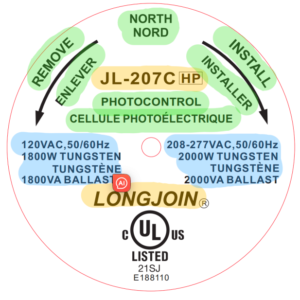How Can I Adjust The Lux Value Setting of My Photo Controller?
Introduce
Photocontrollers are the silent guardians of efficient lighting. These devices seamlessly manage illumination based on the surrounding light levels. They find application in a variety of settings, from automatically turning on streetlights at dusk to regulating building lighting based on natural daylight.
A key factor in this functionality is the lux value setting. Lux, measured in lux units, represents the intensity of visible light. By adjusting the lux value on your photocontroller, you determine the specific light level at which your connected fixtures turn on and off.
This article will guide you through understanding lux value, its role in photocontrollers, and the steps involved in making adjustments for optimal performance.
Understanding the Importance of Lux Measurements
Lux (lx) is the unit used to measure how much visible light reaches a specific area. It tells us the intensity of the light that our eyes can perceive. A brightly lit room will have a higher lux value compared to a dimly lit hallway.
The Role of Lux in Photocontrollers
Photocontrollers use lux measurements to decide when to turn connected lights on and off. They detects the ambient light levels, measured in lux. When the lux level drops below a preset threshold, usually at dusk, the photo controller automatically switches the lights on. And when the lux level rises above, typically at dawn, the lights are turned off again.
Why Adjusting Lux Value Matters
Fine-tuning the lux value setting allows you to optimise your lighting system for various factors. Here’s why adjusting lux value matters.
Energy Efficiency: Setting the correct lux value ensures lights operate only when necessary, reducing energy consumption and costs.
Light Pollution Control: By adjusting for lower lux thresholds at night, you can minimise unnecessary light pollution impacting the environment and nighttime visibility.
Application-Specific Control: Different environments have different lighting needs. Adjusting lux value allows you to tailor lighting activation to specific areas, like brighter lights in parking lots compared to walkways.
Step-by-Step Guide to Adjusting Lux Value
While this guide can be used for general photocontroller principles, our specific focus is the JL-207. This is because they stand out as a reliable option. This microprocessor-based controller offers versatility with its compatibility for various voltage ranges and sensor types.
It boasts features like surge protection and user-friendly time delays, making it a robust choice for automatic lighting control. Below is a step-by-step guide to adjust the lux value.
Accessing Lux Value Setting Interface
The method for accessing the lux value setting interface will differ between photocontroller models. Depending on the specific device, it might involve physical dials, buttons, or software. However, JL-207 usually comes with buttons.
Look for markings or labels near the controls that might indicate “lux” or “light level.” The user manual will be crucial for deciphering these markings and navigating the adjustment process.
Understanding Lux Value Adjustment Options
Once you’ve accessed the lux value setting interface on your photo controller, you’ll likely encounter options for adjusting the turn-on and turn-off thresholds. These thresholds are typically represented in lux units. For instance, you might see options for setting “ON Level” and “OFF Level.”
Suppose you want lights to turn on at dusk or when it’s completely dark, adjust the “ON Level” accordingly. Set a lower “ON Level” for later activation in areas with light pollution restrictions.
Brighter areas like parking lots might require a higher “OFF Level” than walkways.
Tips for Optimal Lux Value Adjustment
- Start with conservative adjustments. It’s easier to fine-tune later if needed.
- Consider consulting online lux level charts to determine appropriate lux values for your environment.
- Test your settings at different times to ensure they function as desired.
Lux value | Environment |
0-0.3 lx | Complete dark |
0.4-0.2 lx | Less dark |
51-100 lx | Dim lighting |
201-400 lx | Good |
401-600 lx | Bright |
600+ lx | Glaring |
Troubleshooting Common Issues
Even with careful adjustment, occasional issues can arise with your photo controller’s lux value settings. Here are some common problems and potential solutions.
Lux Value Not Adjusting
In this case, ensure you’ve adjusted the correct lux value settings (e.g., “ON Level” or “OFF Level”). If using physical dials or buttons, confirm they are not stuck or malfunctioning.
Lastly, refer to the photo controller manual for troubleshooting steps specific to your model.
Inaccurate Lux Readings
Sensor obstruction is a common reason for inaccurate Lux readings. Check if the light sensor on the photocontroller is blocked by dirt, debris, or moisture. Clean it gently with a soft cloth. If cleaning doesn’t resolve the issue, the sensor itself might be faulty.
Consider contacting the manufacturer or a qualified technician. Further, ensure the sensor is positioned in a location with representative ambient light levels and away from direct light sources or obstructions.
Other Potential Problems and Solutions
Lights are not turning on/off at expected times; this could be due to a faulty connection, power supply issue, or timer malfunction. Refer to the manual for troubleshooting steps specific to your photocontroller.
If you encounter any unexpected behaviour beyond lux value adjustments, consult the user manual or contact the manufacturer for further assistance.
Maintaining Lux Value Settings for Optimal Performance
Just like any control system, your photo controller’s lux value settings benefit from regular maintenance to ensure continued optimal performance. Here are some best practices to consider.
- Environmental factors like dust buildup on the light sensor can impact accuracy over time. Schedule periodic inspections to check for obstructions and clean the sensor gently with a soft cloth. It is recommended that you consult the manufacturer’s guidelines for any calibration procedures.
- Seasonal changes in daylight hours or modifications to your surroundings, like adding trees or altering building structures, can influence ambient light levels. Periodically review your lux value settings and make adjustments as needed.
- Integrate lux value checks and adjustments into your lighting system’s regular maintenance routine. This proactive approach will help you identify and address any potential issues early on, ensuring your photocontroller operates efficiently and effectively.
The Bottom Line
Lux value adjustment plays a crucial role in optimising your photocontroller’s performance. With its user-friendly interface and precise functionality, the JL-207, coupled with LONG-JOIN technology, emerges as the top choice for effective illumination management in diverse environments.
By understanding lux and its significance, you can fine-tune settings to achieve efficient lighting control, minimise energy consumption, and tailor light activation to specific needs.







